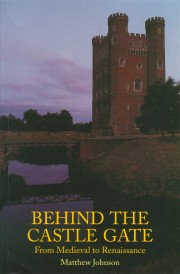We read Matthew Johnson's book Behind the castle gate: From Medieval to Renaissance in week 4 of this course, which centered on the castle at Acrocorinth. I appreciated that week 4, unlike other weeks, focused on a thing which cannot be held in the hands of one person, but is actually a physical setting. Johnson's work with castles was especially interesting, as 'the castle' building type has multiple and tenuous definitions. His book strove to analyze castles in terms of their social implications, rather than taking the traditional approach of studying their military implications. The castle, as explained by Johnson, gathers together many complicated thing/thing, people/thing and people/people relationships. Despite his social lens, though, his conclusion was the following:
- "Castles are not just about defense, not just about class conflict, not just about technological or aesthetic progress, not just about symbolism, and not just about 'a combination of these factors'...In this sense, this book is simply an appeal to castle buffs of all shapes, sizes and variety to go out and look at castles afresh". (1)
I initially found this closing statement a little disappointing, after reading his lengthy book which fully committed to a specific way of unpacking the castle. However, I think it is ultimately a holistic way of approaching such a complex thing-setting. After reading his conclusion, I began to think about other building types that, like castles, have been black-boxed in one way or another.
The skyscraper was the first to come to mind.

Another author from our class readings was instrumental in synthesizing a direction for this project. Bruno Latour's paper "Give Me a Gun and I Will Make All Buildings Move: An ANT's View of Architecture", coauthored with Albena Yaneva, puts forth the following question in this paper:
- "...the problem with buildings is that they look desperately static. It seems almost impossible to grasp them as movement, as flight, as a series of transformations. Everybody knows...that a building is not a static object but a moving project." (2)
I completely agree that viewing architecture as static is problematic, but disagree with the suggestion that "everyone knows" that a building is more than just a container. The fact that buildings are often thought of as static containers would suggest that, in fact, very few people know that a building is a "moving project". I, for one, had not thought much beyond building-as-container before taking multiple architecture and urban studies classes at Brown. These classes have made me consider architectural design and the composition of the urban built environment in ways that I wouldn't have otherwise, and I now view the same buildings and cities that I've been living in and among very differently.
Skyscrapers are a building type that has been traditionally black-boxed as "static object", as put by Latour and Yaneva. Skyscrapers are often talked about in terms of tallest (i.e. what country has claim over the tallest building in the world?). Instead of understanding them in the traditional sense as static, monumental status symbols for corporations or countries, I wanted to deconstruct the skyscraper and examine its wider implications. The Latour/Yaneva article helped me chose dynamic moving project as the lens through which I would deconstruct the skyscraper
This project attempts to offer some history of and observations about the concept of "skyscraper" as it relates to literal and figurative dynamic motion, and also searches for a resolution to the problem put forth by Latour and Yaneva. It is my hope that deconstructing and unpacking this traditionally static thing will allow us to make skyscrapers move.
As with many histories of things we've read, we will begin our journey with origins: 2. The Archetypal Skyscraper.
Footnotes:
1. Johnson, Matthew. Behind the Castle Gate: From Medieval to Renaissance. London: Routledge, 2002. Page 182.
2. Latour, Bruno and Albena Yaneva. "Give me a Gun and I Will Make All Buildings Move: An ANT’S View Of Architecture." Bruno Latour: Pop Articles. 2008. 12 Dec 2008 <http://www.bruno-latour.fr/poparticles/poparticle/P-138-BUILDING-VENICE.pdf>.
Back to Making Skyscrapers Move
